Trends Reports
Measuring Museum Size
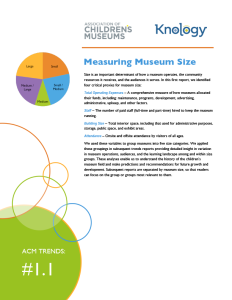
Size plays an important role in how museums operate, what community resources they receive, and what audiences they serve. This report presents four proxies that we use to categorize museums. These are total operating expenses, number of paid staff, total interior space, and attendance by visitors of all ages. Subsequent reports are separated by museum size.
Making a Museum Sing: The Children’s Museums Workforce
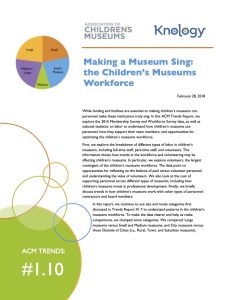
This report focuses on how children’s museums use their personnel, support their team members, and opportunities for optimizing the children’s museums workforce. It explores the different kinds of labor in children’s museums as well as how trends in the workforce and volunteering may be affecting them. It also looks at the costs of supporting personnel including investments in professional development.
Where’s the Money Coming From? Children’s Museums’ Operating Budgets in 2016
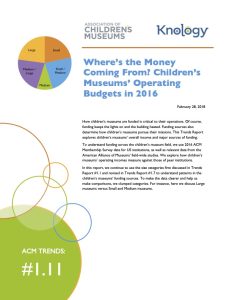
This report explores children’s museums’ overall income and their major sources of funding. It also looks at how children’s museums’ operating incomes measure against those of peer institutions.
Where’s the Money Going? Children’s Museums Expenses
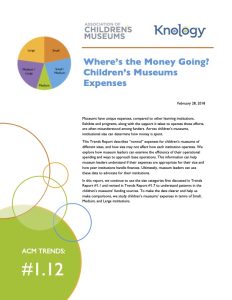
This report looks at how children’s museums use their income and funding. Specifically, it describes “normal” expenses for children’s museums of different sizes, the effect of size on institution’s operations, and ways that museum leaders can examine the efficiency of their operational spending.
Small Museums: Priorities and Opportunities for Growth

Small museums deliver a lot of programs with few resources particularly for school-age children. To reach new audiences and grow, they can leverage their expertise in the early childhood development and learning to develop teacher training resources. Furthermore, increasing their investment in school-based outreach may also help these museums reach new audiences. Lastly, adding an onsite eating facility may draw…
Medium Museums: Priorities and Opportunities for Growth

Current priorities for medium-sized museums include developing and implementing diverse programming for special groups. To keep growing, these museums should expand direct engagement with teachers through training workshops, developing curricular resources, and providing on-site childcare or preschool services. Furthermore, adding an on-premise eating facility may help these museums attract more visitors and create a new revenue stream.
Large Museums: Characteristics and Comparisons
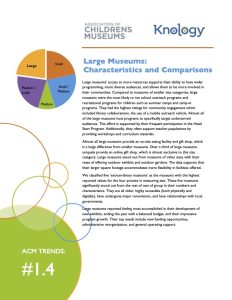
Large museums have access to greater resources, and as a result can offer more programming for diverse audiences. These museums are the most likely to run school outreach and offer recreational programs for children such as summer camps. They also have the highest ratings for community engagement, and almost all provide an on-site eating facility and gift shop. Their top…
Museum Accomplishments and Needs
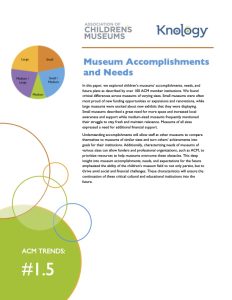
An analysis of over 100 ACM member institutions revealed critical differences in accomplishments, needs, and plans across children’s museums of varying sizes. For example, in terms of accomplishments, small museums highlighted new funding opportunities or expansions and renovations. Large museums, in contrast, highlighted new exhibits that they were displaying. Museums of all sizes expressed a need for additional financial support.
Reaching Nontraditional Families

This report describes the specific challenges faced by nontraditional family units and offers recommendations for how children’s museums may best engage and support them. Many children’s museums consider it part of their mission to engage nontraditional families, who often face obstacles such as poverty, and reduced access to educational resources. They have the opportunity to use their expertise in child…
Using Museum Size and Locale to Understand Capacity
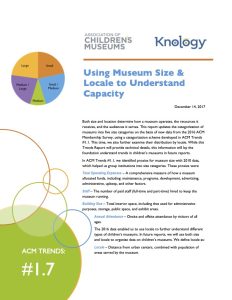
This report updates the categorization of museums into five size categories based on new data from an ACM Membership Survey. It uses several proxies to group institutions into the new size categories. These are: total operating expenses, number of paid staff hired to run the museum, building size, annual attendance by visitors, and location.
Community Engagement: Children’s Museums as Community Facilitators
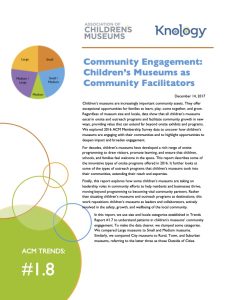
This report explores how children’s museums engage with their communities and highlights opportunities to deepen and broaden that engagement. It describes onsite and outreach programs that some museums are offering as well as highlights ways that they are taking on leadership toles in their communities.
Investing in Systems for Learning: Facilities, Audiences, & Partnerships
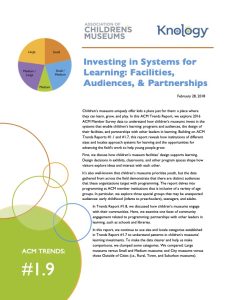
In this report, we sought to understand how children’s museums invest in systems that enable children’s learning. Specifically, we looked at how the design of children’s museum facilities support learning, the distinct audiences that they offer programming for, and how museums partner with other learning organizations such as schools and libraries.
The Economic Impact of Children’s Museums: The Ripple Effect of Spending
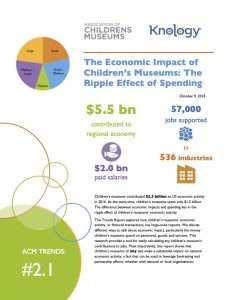
This report explores the large-scale impacts of children’s museums’ economic activity. It covers different ways of talking about economic impact, and shows how children’s museums of different sizes can have a substantial impact on national economic activity.
The Economic Impact of Children’s Museums: Our Jobs, Their Jobs, All Jobs
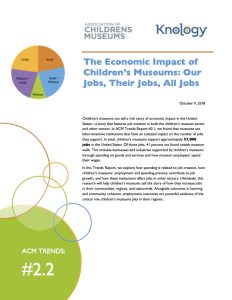
This report explores how spending in children’s museums relates to job creation, and how their employment and spending practices contribute to job growth. It also explores how these institutions affect jobs in other sectors.
The Economic Impact of Children’s Museums: Region Matters
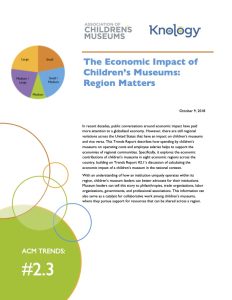
This report explores how children’s museums’ spending on operating costs and employee salaries helps to support the economies of regional communities. It explores the economic contributions of children’s museums in eight economic regions across the US.
“How Are Foundations Investing in Children’s Museums?”
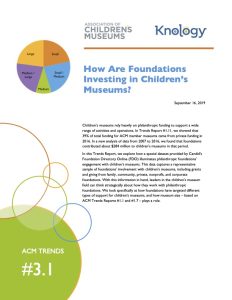
This report focuses on philanthropic investment in children’s museums. Using a representative sample of data on foundations’ involvement, we look at how they target different types of support for children’s museums, as well as the role that museum size plays.
Year
2019
Topic
Foundation Investments in Children's Museums by category and size - Part 1
Changing Priorities in Foundation Grants to Children’s Museums
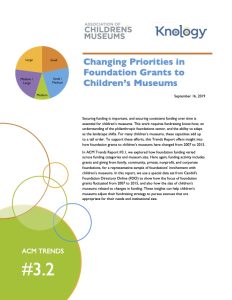
How have foundation grants to children’s museums changed in recent years? This report explores fluctuations in the focus of foundation grants from 2007 to 2015. It offers insights to help children’s museums adjust their fundraising strategies to pursue avenues best suited to their needs and size.
Year
2019
Topic
Foundation Investments in Children's Museums by category and size - Part 2
Measuring Diversity in Children’s Museums & Their Communities
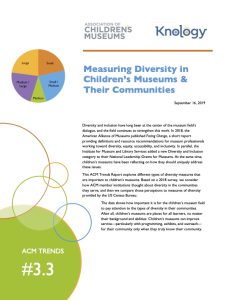
How are children’s museums addressing questions of diversity and inclusion? This report considers the different types of diversity measures that are important to children’s museums.
Museums in a Pandemic: Snapshot of Impacts
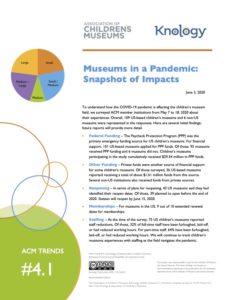
The first report in this volume provides an early overview of the initial effects of the COVID-19 pandemic on children’s museums. It highlights their efforts to find funding, plans for the immediate future, and the effects of the pandemic on staffing and memberships. The following reports delve more deeply into these topics.
Museums in a Pandemic: Collaborations with Cultural Institutions
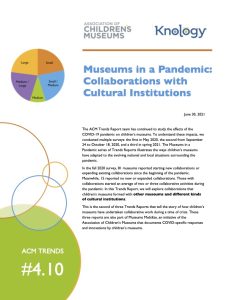
This Trends Report continues the three-part series on collaborations during the pandemic. This time, we examine children's museums' collaborations with other museums and different kinds of cultural museums, including an orchestra, a library, and other children's museums. It features stories from the Building for Kids Children's Museum and KidsQuest Children's Museum.
Museums in a Pandemic: School & University Collaborations
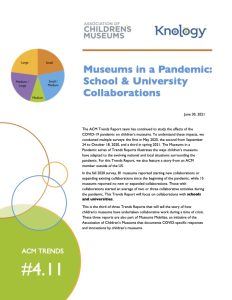
This Trends Report is the final in a three-part special series about children's museums and collaborations. This study explores the most common reasons that museums partnered with schools and universities during this time. It focuses on the collaboration experiences of three institutions: The DoSeum, The Children’s Museum of Richmond, and Play Africa.
Museums in a Pandemic: Personnel & Rebuilding Teams
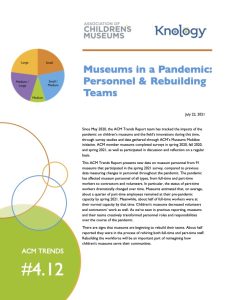
This Trends Reports discusses the impacts of the pandemic and other factors on staffing over from May 2020 to May 2021. It focuses on the ways that museums' full-time staff have been affected, compared to part-time staff. Acknowledging the contributions of many types of personnel, this study also looks at contractors and volunteers. While this Trends Report documents the ways…
Museums in a Pandemic: Patterns in Fundraising
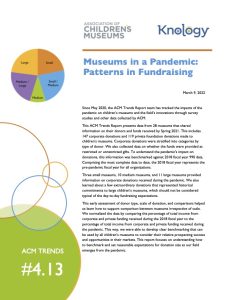
This ACM Trends Report presents data from 28 museums that shared information on their donors and funds received by Spring 2021. This includes 147 corporate donations and 119 private foundation donations made to children’s museums. Corporate donations were stratified into categories by type of donor. We also collected data on whether the funds were provided as restricted or unrestricted gifts.…
Museums in a Pandemic: Confidence in Meeting Operational Needs
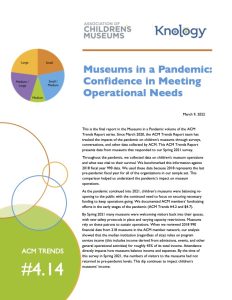
This is the final report in the Museums in a Pandemic volume of the ACM Trends Report series. Since March 2020, the ACM Trends Report team has tracked the impacts of the pandemic on children’s museums through surveys, conversations, and other data collected by ACM. This ACM Trends Report presents data from museums that responded to our Spring 2021 survey.
Museums in a Pandemic: Financial Impacts by Mid-May 2020
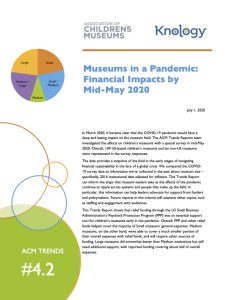
This report focuses specifically on the field’s early efforts to navigate financial sustainability in the wake of the crises. The results can help museum leaders identify next steps, as well as guide their efforts to advocate for support from funders and policymakers.
Museums in a Pandemic: Workforce Impacts
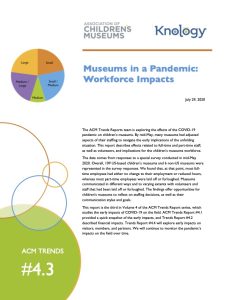
This Trends Report focuses on the children’s museum workforce. Specifically, it looks at the effects of the pandemic on full- and part-time staff, as well as volunteers. Its findings offer opportunities for children’s museums to reflect on staffing decisions. The report also addresses children’s museums’ efforts to communicate with personnel throughout the pandemic.
Museums in a Pandemic: Impacts for Audiences & Partners
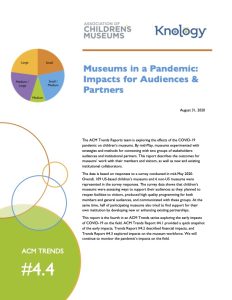
This Trends Report focuses on what children’s museums’ efforts to support their audiences as they prepare to reopen and restart public programming. It also explores how museums are trying to find support for their work by cultivating new or enhancing existing partnerships.
Museums in a Pandemic: Snapshot of Impacts in Fall 2020
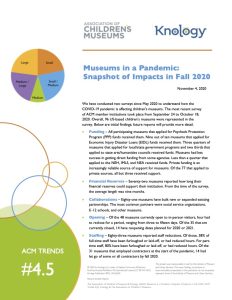
The fifth report in this volume provides a picture of the children's museum field six months into the pandemic. It presents initial impressions of data on funding, financial reserves, collaborations, opening for in-person visitors, and staffing.
Museums in a Pandemic: Audience Experiences
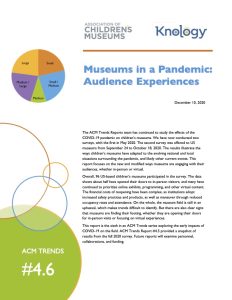
This Trends Report features the complexities of reopening museum buildings to in-person visits, and the costs involved in this undertaking. It examines the wide range of public health and safety measures museums have put into place, and the ways that they have managed on-site visitors. This report also offers a glance at initial costs of reopening for different sizes of…
Museums in a Pandemic: Diversifying Funding Streams
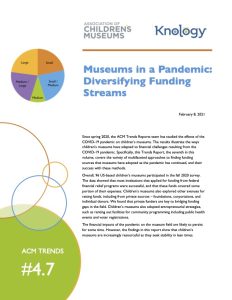
This Trends Report explores the changing landscape of funding and fundraising during the COVID-19 pandemic. With data from a fall 2020 survey, it shows how children's museums have pursued a variety of funding sources. Federal sources continued to play a strong role for these institutions. Meanwhile, private funders -- foundations, corporations, and individual donors -- became increasingly important to children's…
Museums in a Pandemic: Social & Health Services Collaborations
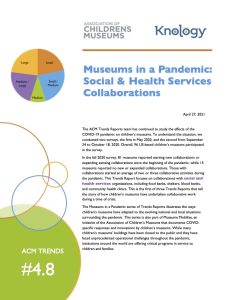
What do collaborations look like during the pandemic? During this time of experimentation for children's museums, collaborative work can take on new signifnance and novel formats. The Trends Report is the first of three to analyze the new or expanded collaborations. This study examines the ways that institutions have partnered with social and health services, including food banks, shelters, blood…
Museums in a Pandemic: Snapshot of Impacts in Spring 2021
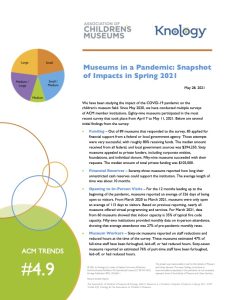
This Snapshot Trends Report provides a brief summary of the results of the spring 2021 survey of children's museums during the pandemic. It covers funding, financial reserves, opening for in-person visits, and the status of museum workers. *Note - This TR was dropped in the middle of the special series on collaborations because of a need to get the Snapshot…
The Expanding Role of Virtual Programming in Children’s Museums

In Volume 4 of the ACM Trends Report series, we focused on the many ways that children’s museums adapted to serving their communities during the COVID-19 pandemic. In October 2021, Knology and the Association of Children’s Museums launched an annual series of discussion forums that bring together a panel of external experts to share recent research that might affect children’s…
Parents & Caregivers Preferences for Virtual Programming
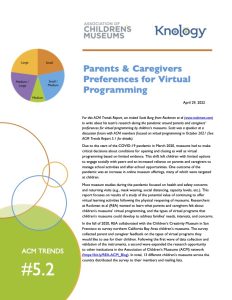
For this ACM Trends Report, we invited Scott Burg from Rockman et al (www.rockman.com) to write about his team’s research during the pandemic around parents and caregivers’ preferences for virtual programming by children’s museums. Scott was a speaker at a discussion forum with ACM members focused on virtual programming in October 2021 (See ACM Trends Report 5.1 for details).
Key Concepts: Trust.
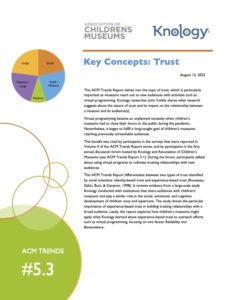
This ACM Trends Report delves into the topic of trust, which is particularly important as museums reach out to new audiences with activities such as virtual programming. Knology researcher John Voiklis shares what research suggests about the nature of trust and its impact on the relationship between a museum and its audience(s). Voiklis offers children's museums some preliminary advice on…
Virtual Programming in Action: National Children’s Museum

We invited staff from National Children’s Museum (NCM) in Washington, DC, to write about their experiences with virtual programming during COVID-19. This trends report (1) looks at the different kinds of virtual programming offered at the museum during the pandemic; (2) provides metrics of engagement with their online offerings, as well as (3) provides insights into the decisions that NCM…
Value Pricing and the Cultivation of Public Trust
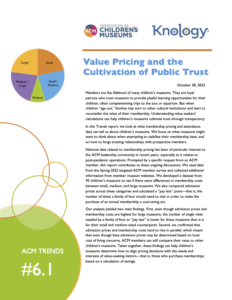
In this report, we analyze data on admission and membership costs, and discuss how museums can combine this data with insights from the scholarly literature on trust to make informed decisions about pricing. When considering price increases, children's museums can counteract impressions that this indicates a lack of benevolence by being more transparent--for example, using website calculators that demonstrate regard…
The ACM Data Hub: Understanding National Averages
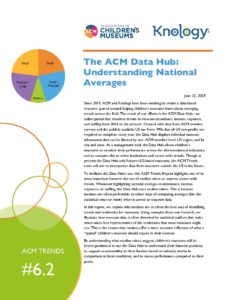
In this report, we introduce the ACM Trends Data Hub--an online portal that allows individual museums to monitor their performance across a number of categories (attendance, income, expenses, and staffing) and compare this both to other institutions and sector-wide trends. Assembled from ACM member surveys and 990 tax forms, the Data Hub is a management tool that children's museums can…
Understanding Museums’ Collaboration Goals
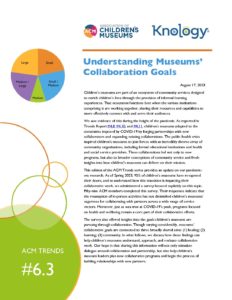
Many children’s museums responded to the COVID-19 crisis by joining forces with other community institutions, working with schools, libraries, government agencies, and social and health services organizations to create new programs in response to urgent community needs. Having previously highlighted the benefits of this development, in this report, we discuss the results of a Spring 2023 follow-up survey designed to…
Collaborating with Libraries: What Children’s Museums Need to Know

This report explores the rewarding possibilities of collaboration for expanding children’s museum programs and details how museums have successfully mobilized partnerships with libraries to work towards shared institutional and community goals. Museums and libraries are increasingly becoming spaces for health and wellness outreach and community building, in addition to more traditional educational programming. To expand their capacity and meet community needs,…
Designing Digital Media for Meaningful Learning
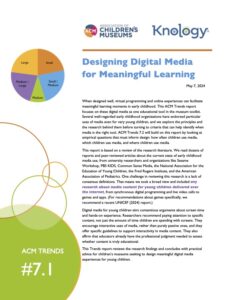
When designed well, virtual programming and online experiences can facilitate meaningful learning moments in early childhood. This ACM Trends report focuses on these digital media as one educational tool in the museum toolkit. Several well-regarded early childhood organizations have endorsed particular uses of media even for very young children, and we explore the principles and the research behind them before…
Meeting Children Where They Are

The world is designed for mobile media, including smartphones and tablets, and young children are already using these tools in a range of settings. This ACM Trends report summarizes what is currently known about the ubiquity of mobile media in young children's lives, including the caregivers’ decisions about their children’s use. We end with a consideration of how children’s museums…
Supporting Bereaved Children: A Guide to Getting Started (Part I)
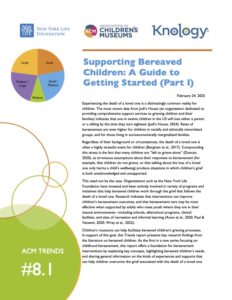
This Trends report presents key research findings from the literature on bereaved children. As the first in a new series focusing on childhood bereavement, this report offers a foundation for bereavement interventions by explaining key concepts, highlighting bereaved children’s needs, and sharing general information on the kinds of experiences and supports that can help children overcome the grief associated with…
